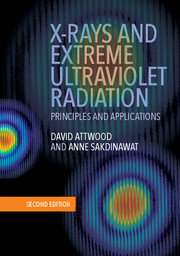Book contents
- Frontmatter
- Dedication
- Contents
- Preface to the Second Edition
- Acknowledgments for the Second Edition
- Preface to the First Edition
- Acknowledgments for the First Edition
- 1 Introduction
- 2 Radiation and Scattering at EUV and X-Ray Wavelengths
- 3 Wave Propagation and Refractive Index at X-Ray and EUV Wavelengths
- 4 Coherence at Short Wavelengths
- 5 Synchrotron Radiation
- 6 X-Ray and EUV Free Electron Lasers
- 7 Laser High Harmonic Generation
- 8 Physics of Hot Dense Plasmas
- 9 Extreme Ultraviolet and Soft X-Ray Lasers
- 10 X-Ray and Extreme Ultraviolet Optics
- 11 X-Ray and EUV Imaging
- Appendix A Units and Physical Constants
- Appendix B Electron Binding Energies, Principal K- and L-Shell Emission Lines, and Auger Electron Energies
- Appendix C Atomic Scattering Factors, Atomic Absorption Coefficients, and Subshell Photoionization Cross-Sections
- Appendix D Mathematical and Vector Relationships
- Appendix E Some Integrations in k, ω-Space
- Appendix F Lorentz Space-Time Transformations
- Appendix G Some FEL Algebra
- Appendix H Ionization Rates of Noble Gas Atoms as a Function of Laser Intensity and Pulse Duration at 800 nm Wavelength
- Index
- References
1 - Introduction
Published online by Cambridge University Press: 24 November 2016
- Frontmatter
- Dedication
- Contents
- Preface to the Second Edition
- Acknowledgments for the Second Edition
- Preface to the First Edition
- Acknowledgments for the First Edition
- 1 Introduction
- 2 Radiation and Scattering at EUV and X-Ray Wavelengths
- 3 Wave Propagation and Refractive Index at X-Ray and EUV Wavelengths
- 4 Coherence at Short Wavelengths
- 5 Synchrotron Radiation
- 6 X-Ray and EUV Free Electron Lasers
- 7 Laser High Harmonic Generation
- 8 Physics of Hot Dense Plasmas
- 9 Extreme Ultraviolet and Soft X-Ray Lasers
- 10 X-Ray and Extreme Ultraviolet Optics
- 11 X-Ray and EUV Imaging
- Appendix A Units and Physical Constants
- Appendix B Electron Binding Energies, Principal K- and L-Shell Emission Lines, and Auger Electron Energies
- Appendix C Atomic Scattering Factors, Atomic Absorption Coefficients, and Subshell Photoionization Cross-Sections
- Appendix D Mathematical and Vector Relationships
- Appendix E Some Integrations in k, ω-Space
- Appendix F Lorentz Space-Time Transformations
- Appendix G Some FEL Algebra
- Appendix H Ionization Rates of Noble Gas Atoms as a Function of Laser Intensity and Pulse Duration at 800 nm Wavelength
- Index
- References
Summary
The X-Ray and Extreme Ultraviolet Regions of the Electromagnetic Spectrum
One of the last regions of the electromagnetic spectrum to be developed is that extending from the extreme ultraviolet to hard x-rays, generally shown as a dark region in charts of the spectrum. It is a region where there are a large number of atomic resonances, leading to absorption of radiation in very short distances, typically measured in nanometers (nm) or micrometers (microns, µm), in all materials. This has historically inhibited the pursuit and exploration of the region. On the other hand, these same resonances provide mechanisms for both elemental (C, N, O, etc.) and chemical (Si, SiO2, TiSi2) identification, creating opportunities for advances in both science and technology. Furthermore, because the wavelengths are relatively short, it becomes possible to study nanoscale structures using the techniques of absorption, scattering and microscopy. To exploit these opportunities requires advances in relevant technologies, for instance in nanofabrication. These in turn lead to new scientific understandings, in subjects such as materials science, surface science, chemistry, biology and physics, providing feedback to the enabling technologies. Development of the extreme ultraviolet, soft and hard x-ray spectral regions is presently in a period of rapid growth and interchange among science and technology.
Figure 1.1 shows that portion of the electromagnetic spectrum extending from the infrared to the x-ray region, with wavelengths across the top and photon energies along the bottom. Major spectral regions shown are the infrared (IR), which we associate with molecular resonances and heat; the visible region from red to violet, which we associate with color and vision; the ultraviolet (UV), which we associate with sunburn and ionizing radiation; the regions of extreme ultraviolet (EUV), soft x-rays (SXR), and finally hard x-rays, which we associate with medical and dental x-rays and with the scientific analysis of crystals, materials, and biological samples through the use of diffraction, scattering, and other techniques. In this book we address techniques and opportunities based on the generation and use of radiation extending from the EUV through x-ray regions of the spectrum.
The extreme ultraviolet is taken here as extending from photon energies of about 30 eV to about 250 eV, with corresponding wavelengths in vacuum extending from about 5 nm to 40 nm.
- Type
- Chapter
- Information
- X-Rays and Extreme Ultraviolet RadiationPrinciples and Applications, pp. 1 - 26Publisher: Cambridge University PressPrint publication year: 2017

